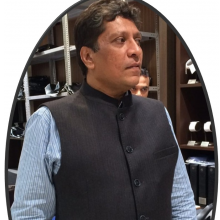Does Your Company Have Inspiring Mission & Vision Statements? Learn How to Create Them

Leadership & Management
499 week ago — 10 min read
An organisation needs to communicate many things to itself and to its stakeholders such as employees, clients, vendors, and the industry as a whole. Apart from its necessary periodic strategic and tactical communication, it needs to communicate larger messages such as:
- Its purpose & values
- Its strategy
- Its measureable goals & objectives
These act as a framework for stakeholders to operate within or operate from (since they act as the beacon that guides their course of action).
Organisations generally do this through vision & mission statements, accompanied by a strategy.
The mission is the largest of these entities and leads to the vision, which in turn leads to the overall strategy.
The Mission – Who we are and what we value
The Vision – What we want to become
The Strategy – How we will achieve what we want to become
The mission and vision are vehicles that communicate the organisation’s purpose and values to all its stakeholders. The more they are internalised by the people within the organisation, the better the outcome. People within the organisation need to live, eat and breathe the vision.
That because, when people understand the good their organisation is doing, they start loving what they do. They are happy to come to work, and they put their heart and soul into their work, because they know it matters. The key word here is that their work matters.
People are genuinely inspired when their organisation has a compelling vision and a clear, worthwhile mission. Crafting powerful vision and mission statements is not difficult. They can be highly motivating when they are expressed clearly and with intent, and when they are communicated effectively to everyone in the organisation. The mission and vision also express an organisation's purpose to its customers, suppliers and the media, on whom they can have a similar effect.
Mission statements define the organisation's purpose and primary objectives. These statements are set in the present tense, and they explain why you exist as a business, both to members of the organisation and to people outside it. Mission statements tend to be short, clear and powerful.
While Vision statements also define an organisation's purpose, they focus more on the organisation’s goals and aspirations. They are designed to be uplifting and inspiring. They have an element of timelessness in them and even if the organisation were to change its strategy, the vision would often remain the same.
Examples Of Mission Statements
Nike – "To bring inspiration and innovation to every athlete in the world”
This statement has certain energy to it. It gives impetus to the R&D and product development teams to come out with new innovations. It sets the framework – it is addressing athletes. But it is large enough to accommodate various products for the athletes – shoes, tracksuits, bags and more.
ConcoPhilips - "Our mission is to power civilization."
Again, the statement is large and yet has focus. It talks of powering. So it talks about energy and civilisation. The focus is clear – it is energy. But the statement is vast in that it talks of energy – which could be electricity, gas, petroleum or even solar. Who knows what the company may want to do tomorrow in the area of energy? It allows the company to think energy production as well as conservation. The target is also broad enough to talk civilisation.
Examples Of Vision Statements
Amazon - "Our vision is to be earth's most customer-centric company where customers can find and discover anything they might want to buy online… at the lowest possible prices."
Ikea - "To create a better everyday life for the many people."
You will notice that the statements
- Give a sense of purpose
- Give direction - the Nike statement gives direction to its designers, its R&D team and also to its marketing team
- Project enthusiasm
- Create a sense of belonging
- Are forward looking
- Bring in energy and excitement
Can a simply worded statement do all of this?
The two statements that we have picked up can do these. It is often up to the manager to take these statements and add more meaning to it and to let its very essence percolate down the ranks.
How to Create a Mission Statement
Step 1: Develop Your Key Idea
Start by identifying your organisation's unique selling proposition (USP) or key idea. This is the idea or approach that differentiates your organisation from the rest, and it is the reason for customers to come to you and not go elsewhere.
Remember that developing a key idea is the essence of business strategy, and it can take a lot of effort to create one, fine tune it and give it the final shape. You could use a mix of models to arrive at this core idea, and a good starting point is to understand the organisation, its SWOT (strengths, weaknesses, opportunities, threats) and its core competence.
Step 2: State Your Goal Clearly
Besides just stating your goal, also ensure that you are able to measure it and measure it well.
For instance, if your key idea is to create the best waterproofing compound in the industry, how will you know when you've actually reached this goal? And if it is to provide superlative service, what parameters will indicate that your customers are truly and completely satisfied?
You need not include exact figures, but some indication and some key metrics would help, so that you know that you have achieved your goal and when you've achieved it.
If necessary, rework and refine this winning idea till you are satisfied and you have created parameters that will help you measure whether you have achieved them or not.
Try and keep this statement in the present tense (we are seen as the best manufacturer of…), and make sure it is complete, clear and concise. Of course, make sure it is free of jargon. The language needs to be inspiring, but not pompous.
How to Create a Vision Statement
Step 1: Identify the human value in the work that you do
First, identify your organisation's mission. Next, try and identify and understand human value in that mission. For example, how do you improve people's lives? How does the organisation make the world a better place?
Step 2: Pull out the essence of these values
You should now try and identify what you, your customers and stakeholders value the most about how your organisation will achieve this mission. Distil these into values that your organisation has, or should have.
Values could be performance superiority, honesty, integrity, teamwork, originality, equality, freedom and/or service.
It is not easy to clearly identify the values – and it makes sense to bounce it off others. What values do they think the organisation stands for, or that it should stand for? This exercise may be an eye opener in itself. Often, the values that organisation believes in are not what are communicated or conveyed covertly or overtly.
Step 3: Combine the mission and values that have been articulated
Now you simply have to combine the mission and values, and polish your words until you have an inspiring statement that will move and energise people within and without the organisation.
This statement should be broad and should not be time constrained – it should be timeless, and it should clearly explain the reason that people in your organisation do what they do.
Here are examples of two companies and their mission and vision statements. The first one is ITC and the other is TVS Motor Company. Read through these and see if you can connect some of the thoughts to what we have just discussed above.
ITC Mission
To enhance the wealth generating capability of the enterprise in a globalising environment, delivering superior and sustainable stakeholder value.
ITC Vision
Sustain ITC's position as one of India's most valuable corporations through world class performance, creating growing value for the Indian economy and the Company's stakeholders.
TVS Mission
We are committed to being a highly profitable, socially responsible, and leading manufacturer of high value for money, environmentally friendly, lifetime personal transportation products under the TVS brand, for customers predominantly in Asian markets and to provide fulfilment and prosperity for employees, dealers and suppliers.
TVS Vision
TVS Motor will be responsive to customer requirements consonant with its core competence and profitability. TVS Motor will provide total customer satisfaction by giving the customer the right product, at the right price, at the right time.
The Industry Leader
TVS Motor will be one among the top two two-wheeler manufacturers in India and one among the top five two-wheeler manufacturers in Asia.
P.S. If you need help in drawing your mission statement, you may link with me on, by clicking on the ‘Invite’ button on my eBiz Card published below.
Posted by
Ajoy VakilYour Virtual Chief Marketing Officer DirectMart offers a host of S.MAR.T services (Strategy, Marketing and Training) that help you reach where you want to go! We help you in...
View Ajoy 's profile
Most read this week
Trending













Comments
Share this content
Please login or Register to join the discussion